Chapter 19 Properties of a Magnetic Field
Textbook Questions and Answers
1. Write the appropriate terms in the blanks:
Question a.
The alloys called …………. and …………. are used for making industrial magnets.
Answer:
alnico, Nipermag
Question b.
A magnetic field can pass through ………… and …………. .
Answer:
cardboard, bottle
Question c.
The intensity of a magnetic field is indicated by the lines of …………. .
Answer:
force
Question d.
The real test of a magnet is ……………… .
Answer:
repulsion
2. With whom should I pair up?
Question a.
Column ‘A’ | Column ‘B’ |
1. Compass | a. The highest magnetic force |
2. Door of a cupboard | b. Like poles |
3. Repulsion | c. A magnet |
4. Magnetic pole | d. A magnetic needle |
Answer:
Column ‘A’ | Column ‘B’ |
1. Compass | d. A magnetic needle |
2. Door of a cupboard | c. A magnet |
3. Repulsion | b. Like poles |
4. Magnetic pole | a. The highest magnetic force |
3. Write answers to the following questions:
Question a.
Distinguish between the two methods of making artificial magnets
Answer:
Single touch method | Double touch method |
1. In this method, one magnet is used to magnetise the steel bar. | 1. In this method, two magnets are used to magnetise the steel bar. |
2. In this method, the magnet is dragged from one end of the steel bar to another end. | 2. In this method, two magnets are dragged from the middle of the steel bar to the opposite directions. |
3. As only one magnet is used to induce magnetism, this method is called single touch method. | 3. As two bar magnets are used to induce magnetism, this method is called double-touch method. |
4. The magnetism created by this method is of low strength and lasts for a short time. | 4. The magnetism created by this method is of high strength and lasts for a longer time. |
Question b.
Which substances are used for making electromagnets?
Answer:
The substances used for making electromagnets are, an iron nail, insulated copper wire, one or more batteries and a pair of wire strippers.
Question c.
Write a note on magnetic field
Answer:
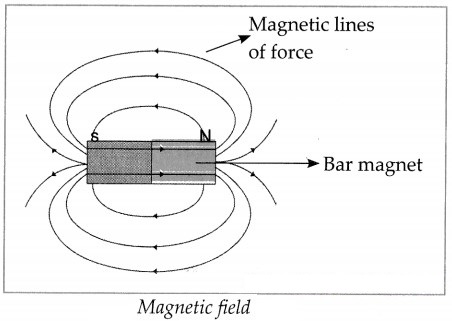
- The region around a magnet where the magnetic force acts on an object is called a magnetic field.
- The magnetic field around a magnet can be shown by means of magnetic lines of force.
- The intensity of the magnetic field can be obtained from the number of lines of force.
- The intensity of a magnetic field is low where the lines of force are sparse and the intensity is high where the lines of force are concentrated.
- A magnetic field is the magnetic effect of electric currents and magnetic materials.
- The magnetic field at any given point is specified by both the direction and the magnitude.
- Magnetic fields are produced by electric current.
Question d.
Why is a magnetic needle used in a compass?
Answer:
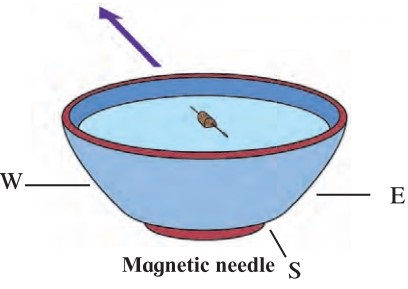
- The magnetic compass is the most familiar compass type.
- It functions as a pointer to magnetic ‘north’ the local magnetic meridian, because the magnetized needle at its heart aligns itself with the horizontal component of the earth’s magnetic field.
- A compass is an instrument used for navigation and orientation that shows direction relative to the geographic cardinal direction.
Question e.
Explain with the help of a diagram how the intensity and direction of the magnetic field of a bar magnet can be determined.
Answer:
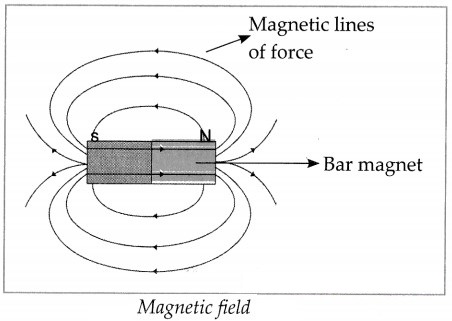
- The region around a magnet where the magnetic force acts on an object is called a magnetic field.
- The magnetic field around a magnet can be shown by means of magnetic lines of force.
- The intensity of the magnetic field can be obtained from the number of lines of force.
- The intensity of a magnetic field is low where the lines of force are sparse and the intensity is high where the lines of force are concentrated.
- A magnetic field is the magnetic effect of electric currents and magnetic materials.
- The magnetic field at any given point is specified by both the direction and the magnitude.
- Magnetic fields are produced by electric current.
4. Give detailed information about how the merchants of olden times used a magnet while travelling.
Question a.
Give detailed information about how the merchants of olden times used a magnet while travelling.
Answer:
- The merchants of older times used a magnet whose north-south side was known.
- When the magnet is freely suspended, the north pole of the magnet settles in the direction of the geographic north pole of the earth.
- This is how the merchants come to know the directions while travelling.
- The idea for using loadstone in a compass first appeared in China.
- The first compass were made of loadstone, a naturally magnetised ore of iron.
- The Chinese used “south pointing spoon” which when thrown upon the ground comes to rest pointing at the south.
- Then the transition was made from loadstone spoons to iron needles.
- In the medieval period a magnetic needle in the shape of a fish, floating in the bowl of water was used as a compass, pointing south.
- It was called floating compass.
- In the twentieth century, liquid filled magnetic compass began to appear.
- There is a lesser known compass called dry mariners compass.
Project:
Question a.
Obtain information about the function of metal detectors.
Important Questions and Answers
Write the appropriate terms in the blanks:
Question 1.
The magnetic lines of force always run from the north pole to the ……………. .
Answer:
south pole
Question 2.
The unit of magnetic field strength is …………….. .
Answer:
A/M (Amperes per metre)
Question 3.
The earth behaves like a giant ………… .
Answer:
barmagnet
Question 4.
The ……………. properties of magnetic field was proposed by scientist
Answer:
Michael Faraday
Question 5.
The region around a magnet where the magnetic force acts on an object is called the …………. .
Answer:
magnetic field
Question 6.
The ……………. of the magnetic field can be obtained from the number of lines of force.
Answer:
strength
Question 7.
The function of the metal detector is based on ………… .
Answer:
electromagnets
Question 8.
The magnetism is ………….. in the case of an electromagnet.
Answer:
temporary
Match the following:
Question 1.
Column ‘A’ | Column ‘B’ |
1. Iron, nickel, cobalt | a. Electromagnet |
2. Doorbell magnet | b. Permanent magnet |
3. Nickel, cobalt, aluminium | c. Iron, nickel, titanium, aluminium |
4. Cupboard magnet | d. Magnetic metals |
5. Lodestone | e. Mariner’s compass |
6. Nipermag | f. Alnico |
Answer:
Column ‘A’ | Column ‘B’ |
1. Iron, nickel, cobalt | d. Magnetic metals |
2. Doorbell magnet | a. Electromagnet |
3. Nickel, cobalt, aluminium | f. Alnico |
4. Cupboard magnet | b. Permanent magnet |
5. Lodestone | e. Mariner’s compass |
6. Nipermag | c. Iron, nickel, titanium, aluminium |
Write True or False correct and rewrite the false statements:
Question 1.
Material alnico is a mixture of aluminium, nickel and iron.
Answer:
False. Alnico is an alloy of aluminium, nickel and cobalt
Question 2.
Nipermag is alloy of iron, nickel, cobalt.
Answer:
False. Nipermag is an alloy of iron, nickel, aluminium and titanium
Question 3.
The magnetic force is concentrated at the centre of the magnet.
Answer:
False. The magnetic force is concentrated at the poles of the magnet.
Question 4.
Magnetism of electromagnet is permanent.
Answer:
False. Magnetism of electromagnet is temporary
Question 5.
Like poles attract each other and unlike poles repel each other.
Answer:
False. Like poles repel each other and unlike poles attract each other
Question 6.
Two poles of a magnet cannot be separated from each other.
Answer:
True.
Answer in one or two sentences:
Question 1.
In which direction does a freely suspended magnet settle?
Answer:
The north pole of a freely suspended magnet settles in the direction of the geographic north pole of the earth. It settles in north-south direction.
Question 2.
Write any two functions of metal detectors.
Answer:
- Metal detectors are used in very important places like an airport, bus station, certain temples and buildings to inspect those who are entering these places.
- To detect very precious articles.
Question 3.
Which magnetic poles attract each other?
Answer:
Opposite magnetic poles attract each other.
Question 4.
What metals are used for making magnets?
Answer:
- Magnets are made from alloys of iron, cobalt and nickel.
- Nipermag is an alloy made up of iron, nickel, aluminium and titanium whereas alnico is an alloy made up of aluminium, nickel and cobalt.
Give scientific reasons:
Question 1.
Earth is called as a gigantic magnet.
Answer:
- The earth is called as a gigantic magnet because north pole of a freely suspended magnet always settles in the direction of the geographic north pole of the earth.
- It means that the South pole of some gigantic magnet must be near the geographic north pole of that magnet, near the geographic south pole of the earth.
- Gilbert inferred from this that the earth itself is a gigantic magnet.
Question 2.
A bar magnet kept on the cardboard arranges the iron fillings in line.
Answer:
- A bar magnet kept on the cardboard arranges the iron fillings in line because of the ‘magnetic lines of force’.
- These magnetic lines gauge the intensity of the bar magnet.
- The intensity of the magnetic field is low where the lines of force are sparse and the intensity is high where the lines of force are concentrated.
- Therefore, the iron fillings arrange themselves according to intensity of the magnetic lines of force.
Write short note on:
Question 1.
Functions of metal detector.
Answer:
- A metal detector is an electronic instrument which detects the presence of metals nearby.
- The function of these machines is based on electromagnets.
- Metal detectors are useful for finding metal inclusions hidden within objects, or metal objects buried underground.
- They often consist of a handheld unit with a sensor probe which can be swept over the ground or other objects.
- Metal detectors in the food manufacturing industry are used to detect and eliminate threats of metal contaminants in food.
- Metal detectors are used in very important places like an airport, bus station, temples, hospitals, railway stations, theaters, malls.
- They are used for inspection of persons entering these places.
- In geology, these machines are used to detect the presence and quantity of metals.
Question 2.
Write down the characteristics of magnets.
Answer:
- A freely suspended magnet settles in the north- south direction always.
- Magnets attract objects of iron, cobalt and nickel.
- The force of attraction of a magnet is greater at its poles than in the middle.
- Like poles of two magnets repel each other.
- Opposite poles of two magnets attract each other.
- If a bar magnet is suspended by a thread and if it is free to rotate its south pole will move towards the north pole of the earth.
Question 3.
Characteristic of magnetic lines of force
Answer:
- Magnetic lines of force start from the north pole and end at the south pole.
- They are continuous through the body of magnet. These are imaginary lines.
- Magnetic lines of force can pass through iron more easily than air
- The number of magnetic lines force determines the strength of the magnetic field at a particular point.
- Two magnetic lines of force do not intersect each other.
- They contract longitudinally and expand laterally.
Can you tell?
Answer the following questions:
Question 1.
Why does freely suspended magnet always settle in the north-south direction?
Answer:
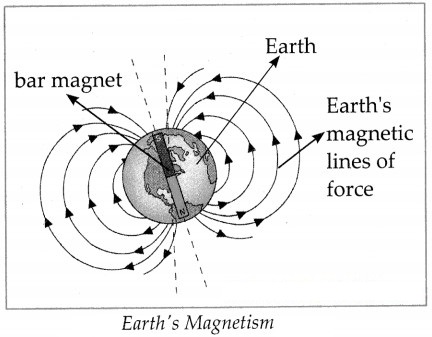
- Gilbert gave a scientific explanation that earth itself is a gigantic magnet.
- The north pole of a freely suspended magnet settles in the direction of the geographic north pole of the earth since unlike poles attract.
- It means that the south pole of some gigantic magnet must be near the geographic north pole of the earth.
- In other words, the thing we call Earth’s geographic north pole is actually the south pole of the magnet inside the earth.
- That is why a freely suspended magnet always settles in geographic north-south attracted by opposite poles of the earth as a great magnet.
Question 2.
Which magnetic poles attract each other?
Answer:
Opposite magnet poles attract each other.
Question 3.
Which pole of a spherical magnet will get attracted towards the south pole of the bar magnet?
Answer:
The north pole of the spherical magnet will get attracted towards the south pole of the bar magnet.
Question 4.
Why does a bar magnet kept at a distance doesn’t attract pins?
Answer:
- The region around the magnet where the magnetic force acts is known as the magnetic field.
- It has its influence over a certain distance where these magnetic lines of force act.
- As these pins are outside this area of influence, a bar magnet does not attract those pins which are at a distance.
Question 5.
What is an electromagnet?
Answer:
- A soft metal core made into a magnet by the passage of electric current through a coil surrounding it is called an electromagnet.
- An electromagnet is a magnet in which the magnetic field is produced by electricity.
- The strength of an electromagnet can easily be changed by changing the amount of electric current that flows through it.
- The poles of an electromagnet can even be reversed by reversing the flow of electricity.
- An electromagnet works because an electric current produces a magnetic field.
- The magnetic field produced by electric current forms circles around the electric current.
- The magnetic field disappears when the current is turned off.
Question 6.
How can an electromagnet be made?
Answer:

- It is easy to make an electromagnet. To make an electromagnet we needs an iron nail of 10 cm length 1 metre long insulated copper wire, a battery cell, pins.
- Neatly wrap some insulated copper wire around an iron nail.
- The more wires you wrap around the nail, the stronger will be the electromagnet.
- Attach a battery to the wire, an electric current will begin to flow and the iron nail will become magnetised.
- When the battery is disconnected the iron nail will lose its magnetism.
Use your brainpower!
Answer the following questions:
Question 1.
Which direction will a magnetic needle show on the geographic north pole?
Answer:
North, all magnetic needle will show north direction.
Question 2.
Is magnetic force a vector or a scalar quantity?
Answer:
- It is a vector quantity. Because a magnetic field is the magnetic effect of electric current and magnetic materials.
- The magnetic field at any given point is specified by both direction and magnitude as such it is represented by a vector field.
Question 3.
What is meant by magnetic force?
Answer:
- The magnetic force, is a consequence of the electromagnet force, one of the four fundamental forces of nature.
- It occurs whenever objects interact in which there is charge in motion, eg. compass, a motor.
- Magnetic force is an attraction or repulsion that arises between electrically charged particles because of their motion.
Question 4.
How does a magnetic force act without direct contact?
Answer:
Magnetic force acts without even direct contact because of the penetrating ability of the magnetic field.
Question 5.
What is the difference between the gravitational force and magnetic force?
Answer:
Gravitational Force | Magnetic Force |
1. Gravitational force acts between any objects with mass. | 1. Magnetic force acts between objects with specific properties. |
2. It depends on the mass of the objects. | 2. It does not depend on the mass of objects. |
3. It acts over long-range as a gravitational field is large. | 3. It acts over short-range as magnetic field is short. |
4. Object are always attracted to each other. | 4. Objects are either attracted or repelled. |
Question 6.
Why is repulsion the real test for identifying a magnet?
Answer:
A magnet can attract the opposite pole of the magnet as well as magnetic substances (iron, cobalt, nickel).
So if a magnet attracts another object, we cannot say that other object is a magnet or a magnetic substance.
But if the magnet repels the object then we can surely say that the other object is a magnet because like poles of magnets repel each other.
Question 7.
How will you find a magnet from among the various articles given to you?
Answer:
- Magnet has the property to attract things made of iron, cobalt, nickel.
- A magnet has magnetic field which is invisible but it has the property of attracting, pulling other
- ferromagnetic material such as iron, cobalt and nickle.
- So if we bring any iron, nickle objects near it, they will be pulled toward the magnet.
- The real test is repulsion.
- The article which shows repulsion when one of the poles of a magnet is brought near is surely a magnet.
Find out:
Answer the following questions:
Question 1.
Why does the magnetic needle of a compass not settle parallel to the ground but at an angle to it?
Answer:
- Freely suspended magnet does not point to north, but aligns to earth’s magnetic field axially ie – north-south.
- The magnetic pole of the earth is different from true north (geographic north) because the magnetic north is constantly changing.
- It leads to a margin of error called declination in which there is an angle of difference (11.51)° between Magnetic North and True North.
- That is the reason the magnetic needle does not settle parallel to the ground.
Observe the diagrams and answer the questions given below:
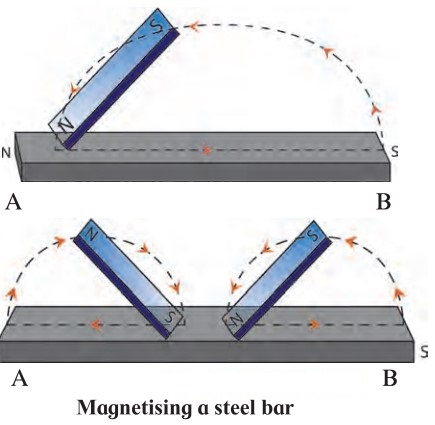
Question 1.
Name the methods shown.
Answer:
Single touch and Double touch methods of magnetising a steel bar.
Question 2.
Give 2 points of difference between the methods.
Answer:
Single touch method | Double touch method |
1. In this method, one magnet is used to magnetise the steel bar. | 1. In this method, two magnets are used to magnetise the steel bar. |
2. In this method, the magnet is dragged from one end of the steel bar to another end. | 2. In this method, two magnets are dragged from the middle of the steel bar to the opposite directions. |
3. As only one magnet is used to induce magnetism, this method is called single touch method. | 3. As two bar magnets are used to induce magnetism, this method is called double-touch method. |
4. The magnetism created by this method is of low strength and lasts for a short time. | 4. The magnetism created by this method is of high strength and lasts for a longer time. |